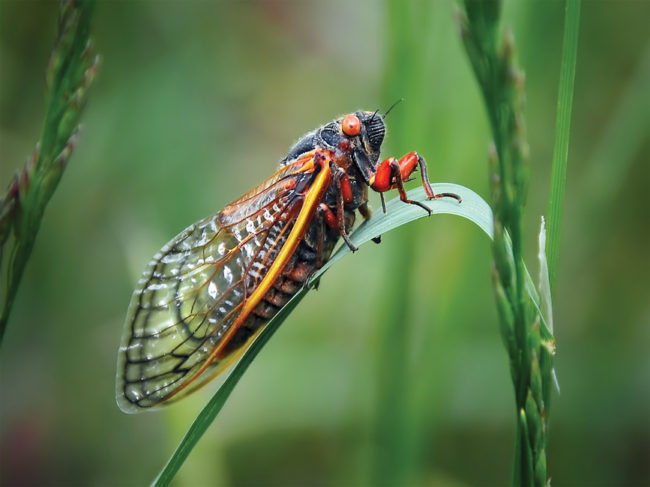
by SUSAN M. BRACKNEY
After 16 years and 11 months of solitary confinement, billions of “Brood X” periodical cicadas will emerge from beneath Bloomington’s parks and neighborhoods, the Indiana University campus, and beyond. “We’re guessing between May 10 and May 15, but it’ll depend on the weather,” says Keith Clay, IU Department of Biology distinguished professor emeritus.
Clay experienced Bloomington’s 17-year cicadas in 1987 and 2004. “[During 2004,] we were counting up to 200 per square meter,” he recalls. “Extrapolate to Monroe County, and it’s in the hundreds of billions [of cicadas.]”
Clay now chairs Tulane University’s Department of Ecology and Evolutionary Biology. “Bloomington is in the center of the highest density of cicada emergence pretty much anywhere in the country,” he says.
When soil temperatures reach 64 degrees, it’s go time. “It’s pretty dramatic,” Clay continues. “The trees, bushes, sides of houses, fences are covered with the shells where they’ve molted.”
Then, males head for the trees to call to potential mates. “It’s an almost deafening raspy buzz,” says Steve Cotter, natural resources manager for the City of Bloomington Department of Parks and Recreation.
However, Cotter says many cicadas never get that far. “They make a loud, screechy alarm call when birds catch them,” he says.
“In 2004, every animal pretty much stopped what they were doing and pigged out on cicadas,” Clay adds. “Dogs, cats, squirrels, turkeys—the following year was a bumper year for turkeys, because they’d gotten so fat from eating cicadas.”
Griffy Lake’s yellow-billed cuckoo population also boomed. “They seemed more common in 2005,” Cotter notes. As for 2021? So much free food may make fish less likely to bite.
Still, humans with adventurous palates are set. “People would have potlucks where every dish was made with cicadas—brownies, pizza, stir-fried in butter,” Clay says.
Female cicadas escaping the plate lay their eggs on twigs. “They can damage the ends of some tree branches,” Cotter says, noting that this year might not be the best time to plant young trees.
Larvae that hatch will tunnel underground, setting their alarms for 2038. Meanwhile, by June’s end, little evidence of the spectacle will remain—other than the name of Cotter’s recreational soccer team. “In 2004, we became ‘Brood X,’” he says. “And we have cicadas on our jerseys!”










